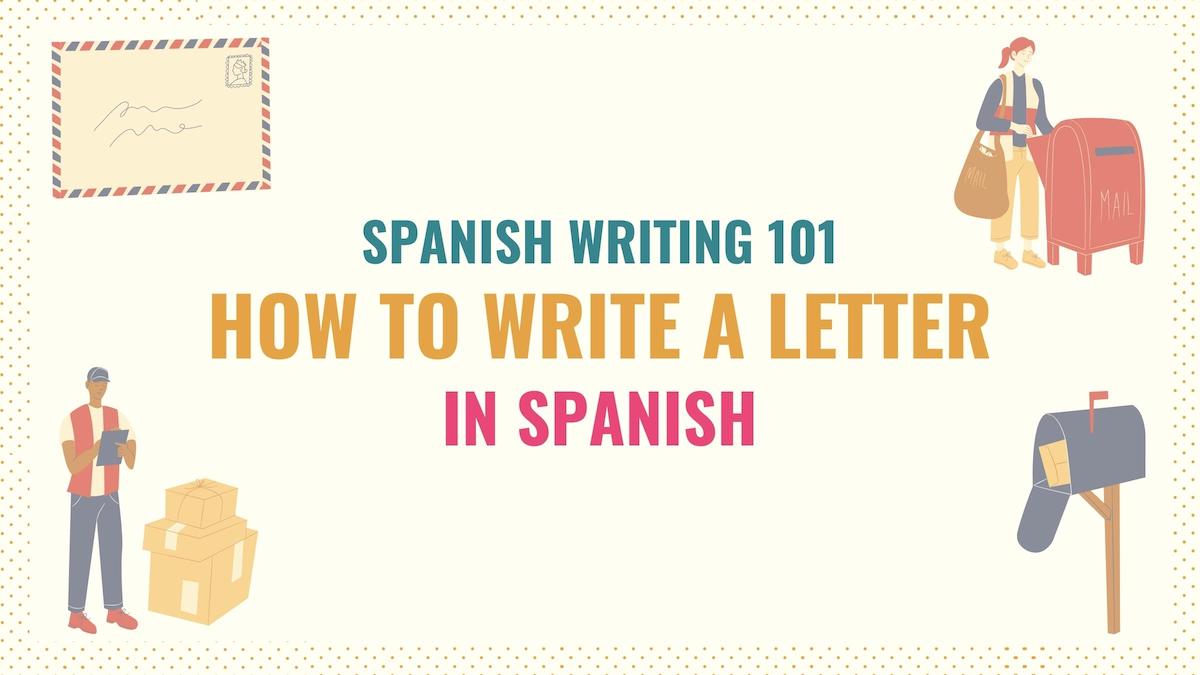The goal of most Spanish learners is to be able to communicate in the language. But, as you know, communication is not limited to verbal conversations. It also includes writing. For that reason, many students are curious about how to write a letter in Spanish.
Whether you need to write a formal or informal letter, there are certain elements and structures you must use when writing letters in Spanish. In this article, you’ll learn all the key information you need to do this successfully. The topics we’ll cover include:
- Writing the Date
- Greetings for a Cover Letter
- Closing a Letter
- Bonus: Extra Vocabulary for Formal & Informal Letters
- Downloadable PDF
Note: This information will also be useful if you need to write an email.
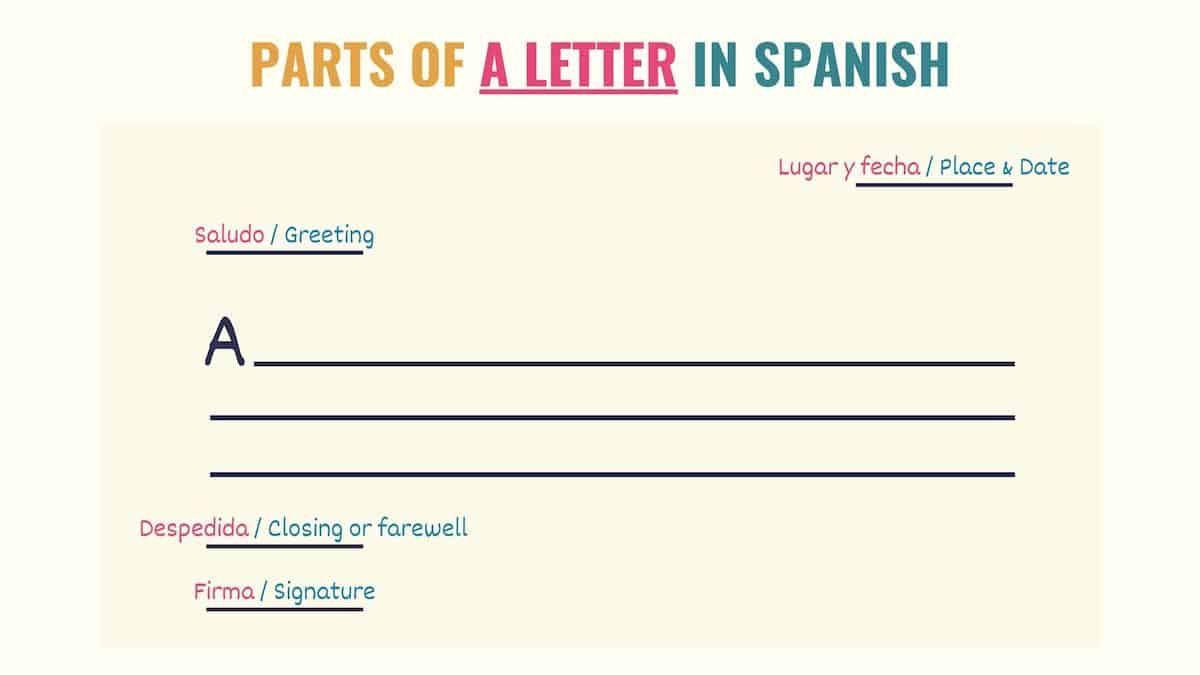
Writing the Date on a Cover Letter in Spanish
As shown in the graphic above, the first element of Spanish a is the date. This element is both applied in informal and formal letters, and you should place it at the right top corner of your card or page.
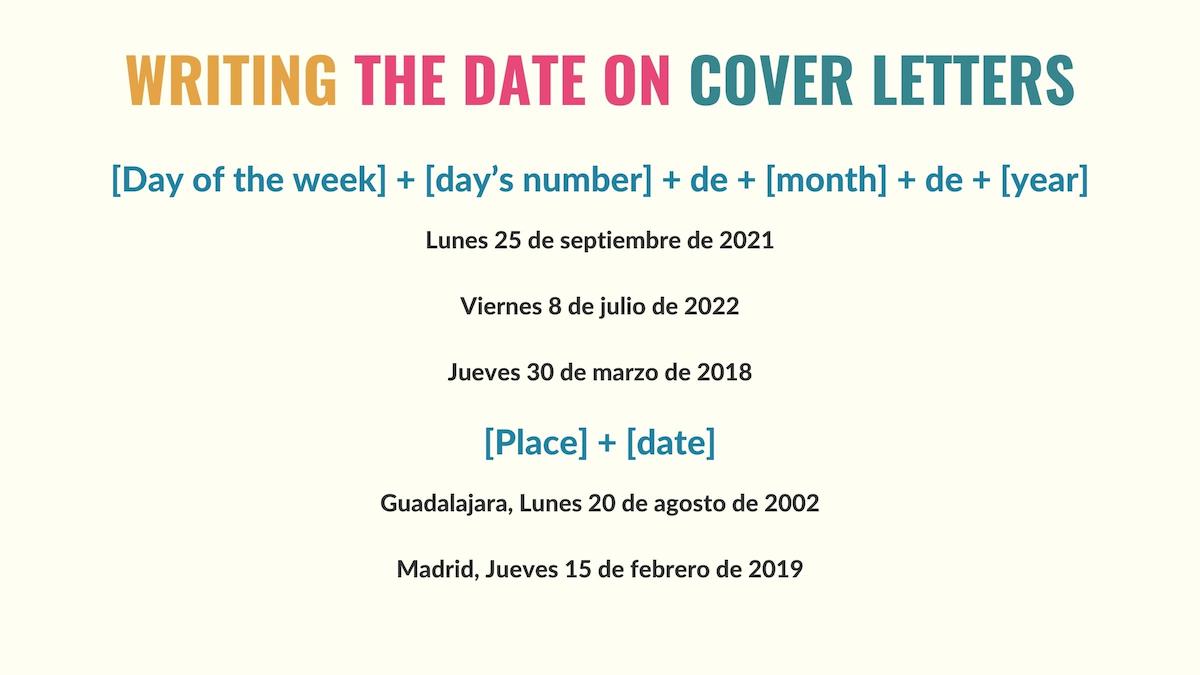
This is the formula you must follow when writing a date on a letter:
[Day of the week] + [day’s number] + de + [month] + de + [year]
Lunes 25 de septiembre de 2021
Viernes 8 de julio de 2022
Jueves 30 de marzo de 2018
Take Note: This formula is only used to add the date when you wrote the letter. If within the body of the letter you must mention a separate date, you’ll follow one of the formulas for writing and saying dates.
In formal letters, the date must be preceded by the place where the content was written. This information is optional in informal Spanish –you may add it if it’s relevant information, such as when sending a postcard from a place you’re visiting.
Here is how you do it:
[Place] + [date]
Guadalajara, Lunes 20 de agosto de 2002
Madrid, Jueves 15 de febrero de 2019
Tip: Since emails automatically include the date, you don’t need to add this element in the body of your email.
Greetings for a Letter in Spanish
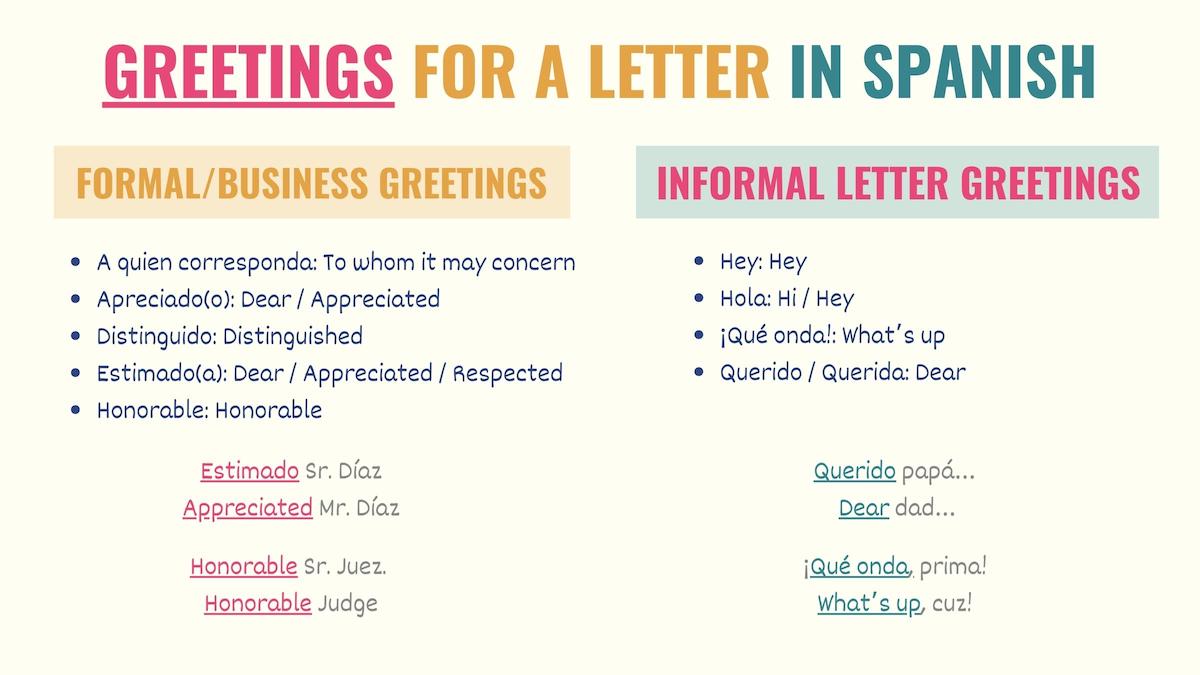
A greeting is a fundamental part of any letter in Spanish. As you can imagine, the formality of this section depends on how formal you need to be. These are some common Spanish greetings that you can use in your letters:
Greetings for a formal and business letter in Spanish
- A quien corresponda: To whom it may concern
- Apreciado(o): Dear / Appreciated
- Distinguido: Distinguished
- Estimado(a): Dear / Appreciated / Respected
- Honorable: Honorable
When writing a business letter in Spanish, if you know this information, your greeting must include the job title of the person you’re writing to. You can also use the abbreviations Sr. and Sra. (Mr. and Mrs.) to formally address people.
For example:
Estimado Sr. Díaz
Appreciated Mr. Díaz
Apreciable Sra.
Dear Madam
Take Note: Estimado marks the gender and number. So, if you were addressing a group of men, you would need to say estimados señores (dear sirs).
Including Professional Titles in your Greetings
When it comes to business letters, it’s common to use the word Ingeniero or its abbreviation Ing. as a job title when writing to engineers. Doctor or Dr. when addressing physicians. And finally, Licenciado or Lic. to address people with other undergraduate degrees.
If you know it, you can also include the specific job title of the recipient:
Estimado Sr. Rector
Appreciated Dean
Honorable Sr. Juez.
Honorable Judge
Informal Spanish: Greetings for an informal letter
| Spanish | English |
|---|---|
| Hey | Hey |
| Hola | Hi / Hey |
| ¡Qué onda! | What’s up |
| Querido / Querida | Dear |
With informal letters, the greeting is followed by the recipient’s name or a word that describes the relationship you two have.
[Greeting] + [noun/name]
Hola, Karla…
Hi Karla…
Querido papá…
Dear dad…
¡Qué onda, prima!
What’s up, cuz!
Take Note: Querido is an adjective that we use to greet people in writing contexts, but, as any other adjective, it needs to mark the gender of the person you’re referring to. Notice that the other greetings must be followed by a comma.
How to Close a Letter in Spanish
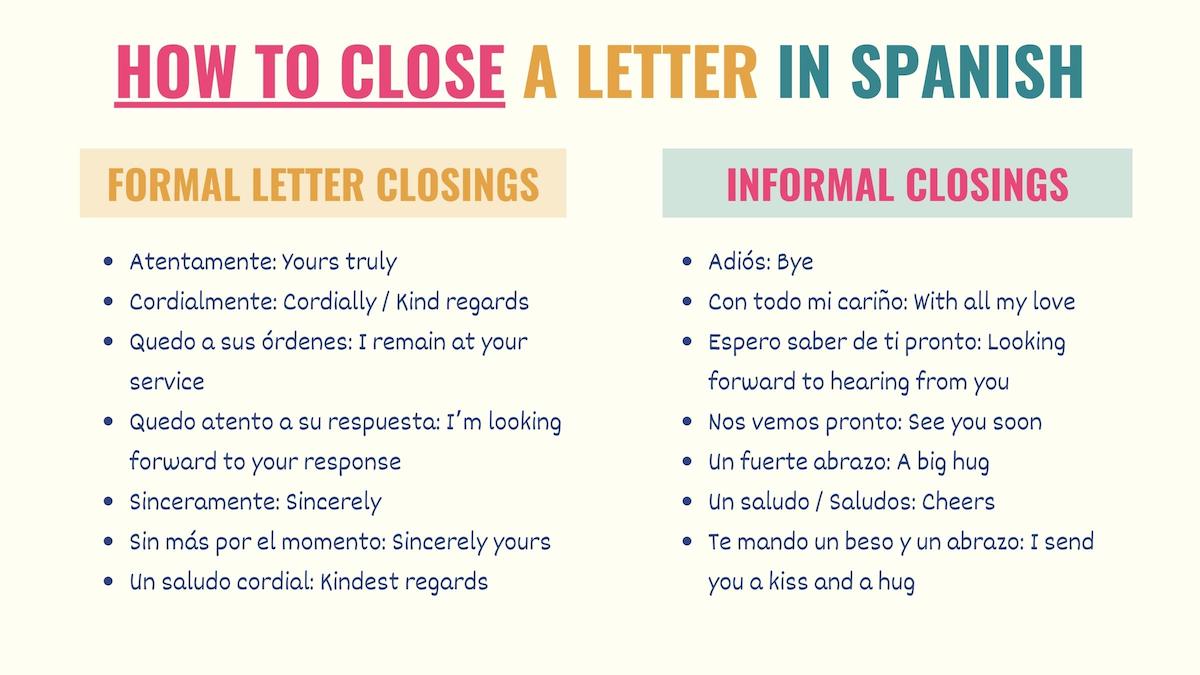
Like your greeting, the closing phrases you use depend on whether you need to use formal Spanish or not. Also, formal and business letters usually include your signature. Here are some formal phrases you can use to close a letter in Spanish:
| Spanish | English |
|---|---|
| Atentamente | Yours truly |
| Cordialmente | Cordially / Kind regards |
| Quedo a sus órdenes | I remain at your service |
| Quedo atento a su respuesta | I’m looking forward to your response |
| Sinceramente | Sincerely |
| Sin más por el momento | Sincerely yours |
| Un saludo cordial | Kindest regards |
On the other hand, examples of informal closings include:
| Spanish | English |
|---|---|
| Adiós | Bye |
| Con todo mi cariño | With all my love |
| Espero saber de ti pronto | Looking forward to hearing from you |
| Nos vemos pronto | See you soon |
| Un fuerte abrazo | A big hug |
| Un saludo / Saludos | Cheers |
| Te mando un beso y un abrazo | I send you a kiss and a hug |
Bonus: Extra Vocabulary for Formal Letters
So far you’ve learned how to write the date as well as the many greetings and farewells you can use for formal and informal letters. But you still have to work on the body of your letter. Bad news… I’m not able to write this for you!
What I can do, though, is give you some standard phrases you may be able to insert here and there. Since formal writing is more challenging, I’ll focus on this type of language. Also, be mindful that writing formal or informal letters means that you’ll have to use the formal or informal way to say ‘you’ in Spanish.
| Spanish | English |
|---|---|
| Ante todo… | Above all… |
| El motivo de esta carta… | The reason for this letter… |
| En respuesta a su petición… | In response to your petition… |
| Hago constar… | I make known to you… |
| Le agradezco su tiempo y atención… | I appreciate your time and attention… |
| Le escribo con el objeto de… | I write to you with the purpose of… |
| Me dirijo a usted para… | I address you to… |
| Me gustaría informarle / comunicarle… | I would like to let you know… |
| Para pedirle su apoyo… | To request your support… |
| Por medio de la presente… | Through the present letter… |
| Solicito su apoyo para… | I request your support for… |
To improve the readability of your letters, make sure to learn some transitional words.
Tip: Most people writing letters to friends and family are trying to do it to wish their best on a holiday (such as Christmas or father’s day) or a celebratory day such as a person’s birthday. If this is your case, you should check my article on ‘How to Say Congratulations’ so you can find useful phrases to convey your message.
Download PDF: Writing a Letter in Spanish (Formal & Informal)
Now that you’ve learned the essential vocabulary and phrases involved in an email or letter in Spanish, you’re ready to start writing! However, in order to make the most out of this guide and expand your conversational skills over time, you’ll likely want to use different greetings, farewells and other vocab for different recipients over time. Download a free copy of the PDF including all the sentences and vocab on how to write letters to use whenever you need it!

